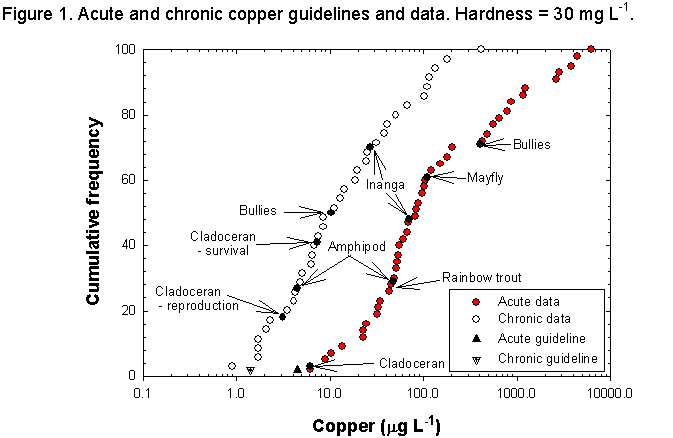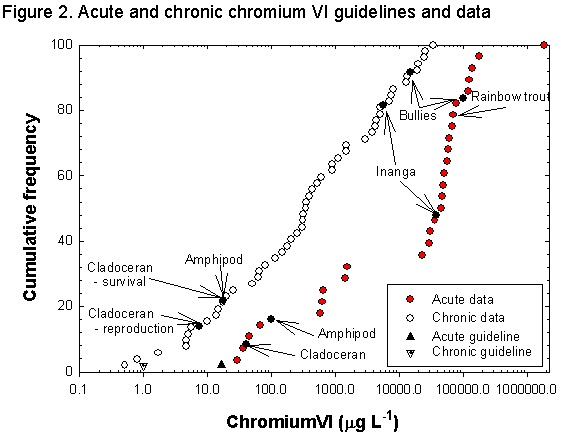|
The sensitivity of the test species to individual chemicals is compared to published values for other native and overseas species and ranked to determine the relative sensitivity and for numeric guideline derivation (Figures 1 & 2 below). The sensitivity of the test species are also compared to a benchmark species (e.g. rainbow trout). Acute guidelines are derived for short-term exposures (e.g. stormwater run-off events) while chronic guidelines are suitable for protection from adverse effects associated with long-term exposures. A wide range in sensitivity is commonly found between species (e.g. a range of approximately 1,000 times for copper � Figure 1), indicating considerable scope for the development of site-specific guidelines. Site-specific guidelines incorporate specific species selection and factors which might adjust the bioavailability of contaminants. Schemes for site-specific adjustment are included in the revised ANZECC water quality guidelines (ANZECC 2000). CopperThe test results were standardised to a total hardness of 30 mg L-1 CaCO3 and showed a range of sensitivities (Figure 1). For the acute tests, there was a 66-fold range of sensitivity between the test species. The cladocera were the most sensitive (48h LC50 = 6.12 m g L-1), and the bullies the least sensitive (96h LC50 = 404 m g L-1). Results from published values for rainbow trout and the native mayflies (Deleatidium spp) were also included in the rankings. Cladocera were approximately 7.5 times more sensitive than rainbow trout and are one of the most sensitive species in the ranking (30%ile). Bullies were approximately 9 times less sensitive than rainbow trout, and the amphipods had a similar sensitivity to rainbow trout (48h LC50 = 47 m g L-1). The chronic test results showed that cladocera were again the most sensitive species tested (7d reproduction EC50 = 3.1 m g L-1), but inanga were the least sensitive (21d survival LC50 = 27.1 m g L-1). Both fish species were in the upper 50%ile of the acute and chronic datasets, indicating a relatively low susceptibility to copper exposure. The greater sensitivity of rainbow trout indicates that trout would provide a useful surrogate for protection of the native species. Amphipods and cladocerans were in the lower 30%ile indicating high sensitivity and the potential for these species to provide sensitive indicators for ecosystem protection. The acute guideline is from US EPA (1996) and the chronic guideline from ANZECC (2000). Chromium VIFor the acute tests, the test species showed a 2,400-fold range of sensitivity to chromium (Figure 2). Cladocera were the most sensitive test species (48h LC50 = 41 m g L-1), and was in the most sensitive 10% of species used in the ranking. Bullies were the least sensitive test species (96h LC50 > 100,000 m g L-1). The invertebrates (cladocera and amphipods) showed a much greater sensitivity than the fish species (inanga and bullies). Similarly the chronic test results showed that cladocera and amphipods were much more sensitive than the fish species (inanga and bullies), and cladocera reproduction was within the most sensitive 15% of the species used in the ranking. The marked difference between fish and invertebrate species sensitivities indicates that site-specific guidelines could consider the different exposure risks to these groups. The acute guideline is from USEPA (1996) and the chronic guideline from ANZECC (2000). Arsenic VNo guideline derivations have been undertaken to provide acute and chronic datasets for comparison of the relative sensitivity of species to arsenic V. Cladocerans and amphipods were markedly more sensitive than fish species. Sensitivity ranged 69X for acute exposures and 288X for chronic exposures (see the summary data tables for freshwater invertebrates and freshwater fish).
|
![]()

